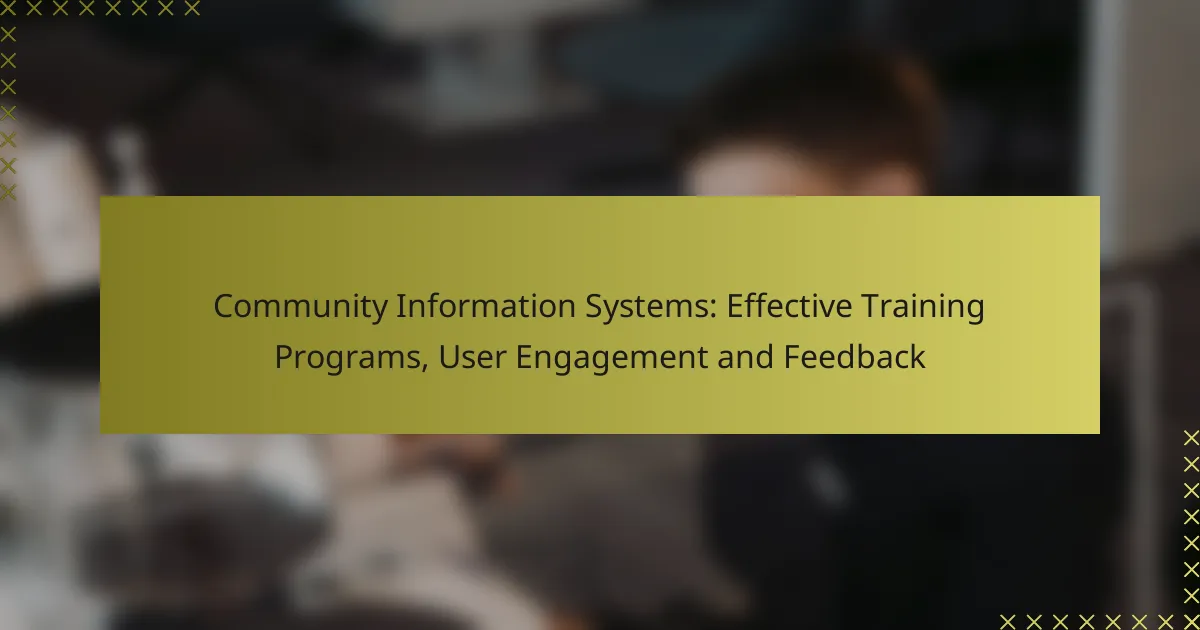Community information systems thrive on effective training programs that empower users with essential skills for optimal utilization. By incorporating diverse instructional methods, these programs cater to various learning styles, ensuring users gain a comprehensive understanding. Enhancing user engagement through interactive strategies and supportive environments further promotes active participation, while robust feedback mechanisms help organizations refine system functionality based on user insights.

What are effective training programs for community information systems?
Effective training programs for community information systems focus on equipping users with the necessary skills to utilize these systems efficiently. They typically combine various instructional methods to cater to different learning preferences and ensure comprehensive understanding.
Online training modules
Online training modules offer flexibility and accessibility, allowing users to learn at their own pace. These modules often include video tutorials, interactive quizzes, and downloadable resources, making them suitable for diverse learning styles.
To maximize effectiveness, ensure that the content is regularly updated and aligned with the latest system features. Incorporating user feedback can also enhance the relevance and engagement of the training materials.
In-person workshops
In-person workshops provide hands-on experience and real-time interaction with trainers, which can significantly enhance learning. These sessions allow participants to ask questions and engage in discussions, fostering a deeper understanding of the community information systems.
Consider scheduling workshops in small groups to encourage participation and personalized attention. Providing follow-up resources can help reinforce the concepts covered during the sessions.
Blended learning approaches
Blended learning combines online and in-person training methods, offering the benefits of both formats. This approach allows users to complete foundational knowledge online before engaging in hands-on practice during in-person sessions.
When implementing blended learning, ensure that the online components are well-integrated with the in-person activities. This can create a seamless learning experience that reinforces key concepts and skills.
Certification programs
Certification programs validate users’ skills and knowledge in community information systems, providing a sense of achievement and credibility. These programs often include assessments that test users on practical applications of the system.
To be effective, certification programs should be recognized by relevant industry bodies and include ongoing education requirements to keep skills current. This encourages users to stay engaged with the system and its updates.
Case studies from successful implementations
Case studies showcase real-world examples of successful training programs for community information systems, highlighting best practices and lessons learned. They can serve as valuable resources for organizations looking to implement similar programs.
When reviewing case studies, focus on the specific strategies used, the challenges faced, and the outcomes achieved. This can provide actionable insights and inspire confidence in the training approach adopted.

How can user engagement be improved in community information systems?
User engagement in community information systems can be enhanced through various strategies that focus on interactivity, motivation, and ongoing communication. By implementing user-friendly interfaces, gamification, regular feedback mechanisms, and supportive community spaces, organizations can foster a more active and involved user base.
Interactive user interfaces
Creating interactive user interfaces is essential for improving user engagement in community information systems. These interfaces should be intuitive, allowing users to navigate easily and access information quickly. Incorporating features like drag-and-drop functionality, customizable dashboards, and responsive design can significantly enhance the user experience.
Consider conducting usability testing to gather insights on how users interact with the system. This feedback can guide necessary adjustments to the interface, ensuring it meets user needs and preferences effectively.
Gamification techniques
Gamification techniques can motivate users to engage more actively with community information systems. By incorporating elements such as points, badges, and leaderboards, users are encouraged to participate and complete tasks. This approach taps into users’ competitive nature and can lead to increased interaction and retention.
When implementing gamification, ensure that the rewards are meaningful and aligned with user goals. For example, offering tangible benefits like discounts or exclusive content can enhance the perceived value of participation.
Regular feedback loops
Establishing regular feedback loops is crucial for maintaining user engagement in community information systems. This can be achieved through surveys, polls, and direct communication channels where users can share their thoughts and experiences. Regularly soliciting feedback shows users that their opinions matter and can lead to improvements based on their suggestions.
Consider setting up a schedule for feedback collection, such as quarterly surveys, to keep users engaged and informed about changes made in response to their input. This transparency fosters a sense of community and ownership among users.
Community forums and support groups
Community forums and support groups provide users with a platform to connect, share experiences, and seek assistance. These spaces encourage collaboration and can significantly enhance user engagement by fostering a sense of belonging. Users are more likely to remain active when they feel part of a supportive community.
To maximize the effectiveness of these forums, ensure they are moderated and organized by topics of interest. Regularly highlighting popular discussions or success stories can keep the community vibrant and encourage new users to participate.

What feedback mechanisms are effective for community information systems?
Effective feedback mechanisms for community information systems include methods that gather user insights and experiences to improve system functionality and user satisfaction. Utilizing a combination of surveys, user testing, focus groups, and analytics can provide a comprehensive understanding of user needs and preferences.
Surveys and polls
Surveys and polls are straightforward tools for collecting user feedback on community information systems. They can be distributed online or in person and typically include multiple-choice questions, rating scales, and open-ended responses. Aim for a response rate of at least 20-30% to ensure the data is representative.
When designing surveys, keep questions clear and concise. Use a mix of quantitative and qualitative questions to capture both measurable data and personal insights. Consider offering incentives, such as small gift cards or community recognition, to encourage participation.
User experience testing
User experience testing involves observing real users as they interact with the community information system. This method helps identify usability issues and areas for improvement. Conduct tests with a diverse group of users to gather a wide range of feedback.
During testing, focus on specific tasks that users need to accomplish and record their actions and reactions. Aim for sessions lasting about 30-60 minutes, which allows enough time to gather meaningful insights without causing fatigue. Analyze the results to pinpoint common pain points and prioritize fixes.
Focus groups
Focus groups bring together a small group of users to discuss their experiences and opinions about the community information system. This qualitative method fosters in-depth conversations and can uncover insights that surveys might miss. Typically, a focus group consists of 6-10 participants and lasts about 1-2 hours.
To facilitate effective discussions, prepare a set of guiding questions but allow for open dialogue. Ensure a comfortable environment to encourage honest feedback. Record the session for later analysis, and consider using a skilled moderator to keep the conversation focused and productive.
Analytics and usage data
Analytics and usage data provide quantitative insights into how users interact with the community information system. By tracking metrics such as page views, session duration, and user pathways, you can identify trends and areas for improvement. Tools like Google Analytics or specialized software can help gather this data.
Regularly review analytics to spot patterns, such as high drop-off rates on specific pages or features that are rarely used. This information can guide enhancements and inform decisions about which features to prioritize. Aim to analyze data at least monthly to stay responsive to user needs.

What are the prerequisites for implementing community information systems?
Implementing community information systems requires careful consideration of several key prerequisites. These include securing stakeholder buy-in, establishing the necessary technical infrastructure, and providing adequate training resources to ensure effective use.
Stakeholder buy-in
Gaining stakeholder buy-in is crucial for the successful implementation of community information systems. This involves engaging community leaders, local organizations, and potential users early in the process to gather input and foster support.
Effective communication about the benefits and goals of the system can help mitigate resistance. Regular meetings and updates can also maintain interest and commitment from stakeholders throughout the implementation phase.
Technical infrastructure
A robust technical infrastructure is essential for supporting community information systems. This includes reliable internet access, appropriate hardware, and software that meets the community’s needs.
Assessing existing resources and identifying gaps is a critical step. Communities may need to invest in upgrades or new technologies, which should be budgeted appropriately to avoid unexpected costs.
Training resources
Providing comprehensive training resources is vital for ensuring users can effectively engage with the community information system. Training should be tailored to different user groups, addressing varying levels of technical expertise.
Consider offering a mix of in-person workshops, online tutorials, and user manuals. Regular follow-up sessions can reinforce learning and address any ongoing challenges users may face.

How to choose the right community information system?
Choosing the right community information system involves assessing your community’s specific needs, available features, and user engagement capabilities. Consider factors such as ease of use, scalability, and the ability to gather feedback effectively.
Feature comparison
When comparing features of community information systems, focus on key functionalities like data management, user interface, and integration capabilities. Look for systems that offer customizable dashboards, user-friendly navigation, and compatibility with other tools your community may already use.
For example, a system that allows for real-time updates and mobile access can enhance user engagement significantly. Evaluate whether the system supports various communication methods, such as forums, surveys, and notifications, to keep users informed and involved.
Additionally, consider the level of support and training provided by the vendor. Systems that offer comprehensive onboarding and ongoing assistance can help ensure successful implementation and user satisfaction. Make a checklist of essential features and rank them based on your community’s priorities to streamline your decision-making process.



